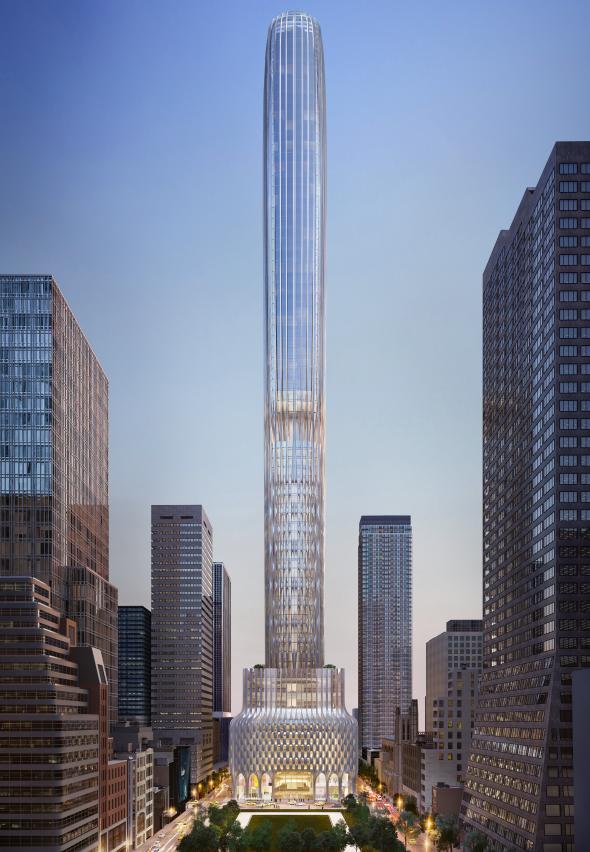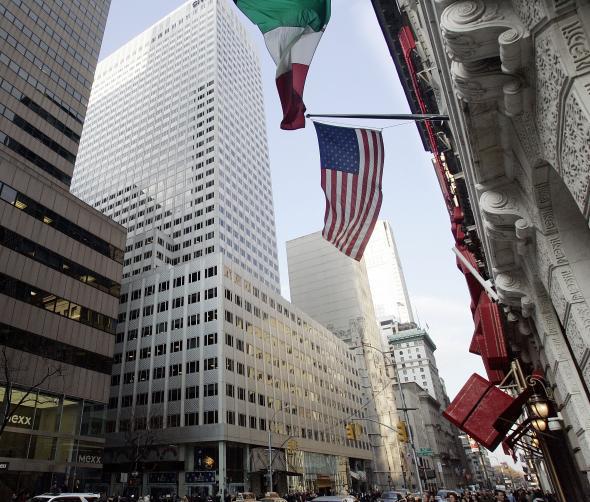Before Jared Kushner was charged with innovating the federal government and bringing peace to the Middle East, he was, like his father-in-law, a developer in midtown Manhattan.
On his 26th birthday in 2007, shortly before the first tremors of the financial crisis, Kushner made a bet that looked wild even through the rose-tinted glasses of New York developers. Kushner Companies, which Jared had helped lead since his father, Charles, was sentenced to prison in 2005 for tax evasion and other crimes, bought the 41-story, aluminum-clad office building at 666 Fifth Ave. for $1.8 billion.
At the time it was the most expensive single building ever sold in the United States. It didn’t make money then. It certainly didn’t make money during the financial crisis. And it doesn’t make money now.
Its travails, from the heady moment of sale through a series of deals to assuage the initial miscalculation, have been the subject of fascination in the New York media. On top of that, for the past year, Kushner Companies has been seeking to assemble more than $7 billion in financing to convert the existing structure into a glass tower of condos, about twice the current height, designed by the late Zaha Hadid. The General Motors Building, about five blocks away, is considered the most valuable building in Manhattan at $3.4 billion. The Kushners’ would cost more than twice that much to build.
666 Fifth Ave. was supposed to be the crown jewel of the Kushner empire. Instead it’s a 41-story metaphor for the international real estate conflicts that have trailed Jared Kushner, and President Trump, to Washington. It’s a reminder that no matter how much Trump and Kushner make a show out of separating themselves from their real estate empires, the business and the fortunes of their families in New York are closely entwined with the highly scrutinized interactions of global diplomacy.
The Kushners were multifamily developers from New Jersey, and the purchase of 666 Fifth Ave. signaled their intentions in Manhattan—and the “debut” of young Jared, who not long before had been enrolled in a business and law degree program at New York University. “I love New York—it’s the greatest city in the world,” Kushner told the Real Deal after he closed the deal in 2007. “In this particular transaction, we bought really the center of the world, Fifth Avenue and 52nd Street. It doesn’t get any better than that.”
Ten years later, the 1957 building once again feels like it’s at the center of the world. In January, the New York Times reported that the Kushners were in talks with Anbang Insurance Group, a Chinese company with close ties to the Chinese government. In March, Bloomberg reported the details: Anbang would have paid the Kushners $400 million as part of a deal that valued the money-losing, soon-to-be-demolished building at $2.85 billion. The company would also have helped the Kushners procure a $4.1 billion construction loan for the redevelopment, about three times what experts say is typical for the area.

Kushner Companies/Zaha Hadid Architects
Those talks had lasted for nearly nine months before collapsing in late March. The cause, a Kushner spokesman told the New York Times, was that the speculation surrounding the deal had become a distraction.
You can see why. Jared Kushner divested from the building in January, but Kushner Companies is still a family business. And while the firm courts foreign banks and investors, Jared Kushner maintains a nebulous, wide-ranging role in the Oval Office. Kushner is considered a key figure in diplomatic relations with China—he orchestrated, in February, a conciliatory phone call between President Trump and Chinese President Xi Jinping. (Kushner also met in December with the Sergey Gorkov, the head of a Russian state–owned bank, in a meeting that was arranged by the Russian ambassador to the United States and not disclosed on Kushner’s application for security clearance.)
A transaction of that size would likely have been subject to review by the Committee on Foreign Investment in the United States, which has stalled Anbang’s efforts before. The deal for 666 Fifth Ave. also called for $850 million in financing from EB-5, a program that gives visas to Chinese investors in U.S. real estate projects and businesses. Designed for distressed areas, the program—which is also subject to federal oversight—has been used extensively for tony projects by the Trumps and the Kushners, among others.
Finally, observers believed the terms of the Anbang deal were unusually generous, raising the concern that the prospect of influence in Washington might have sweetened the terms for the Chinese firm. Anbang has a reputation for overpaying for New York real estate. But even so, the valuation of $2.85 billion, which seemed high, was more than three times what the property was supposed to be worth in 2011 and about 40 percent higher than its (overinflated) 2007 valuation, even though office rents in midtown are no higher now than they were then.
That deal is dead. But the Kushners find themselves in an increasingly desperate position.
Over the past decade, to stave off default, the Kushners have sold off bits and pieces of their prize asset: They sold the retail space, the most valuable part of the building, in 2010. The next year, they sold half of the building to Vornado, a publicly traded real estate trust. And they restructured the debt under terms that gave them a short-term reprieve but have lately become more onerous. An escalating series of fees kicked in last month, Bloomberg reported, and interest on the loan jumps in December. The rest of the $1.2 billion mortgage loan is due in less than two years.
Normally, an owner would then take out a larger loan based on the building’s increased value, pay off the old one, and carry on making money. But 666 Fifth Ave. doesn’t make money and hasn’t for at least two years. Interest rates are higher now. Banks are more conservative. More than a quarter of the office space is vacant. The building is likely worth less than what they paid for it—unless a foreign investor like Anbang decides to make an extremely optimistic assessment.
To make matters more complicated, Esquire reported this summer that Vornado CEO Steve Roth, who owns half the building, does not share the Kushners’ vision of luxury condos and believes the building is better off as office space.
Charles Kushner, by contrast, reportedly thinks the building’s true value is in the “dirt”—its choice midtown location. It is supposed to be the site of his dream building. But the price of that dream is far beyond the scope of anything that has ever been built in Manhattan.
The construction loan alone is unprecedented, experts said, and no bank in America would take that kind of risk. And so if Charles Kushner is confident he can put together a deal for an 80-story residential tower, with condos selling for $6,000 per square foot, and a megamall at the base—and he says he is—he’ll need to look for financing from abroad.
Which means his son’s job could be both an asset and an obstacle.
